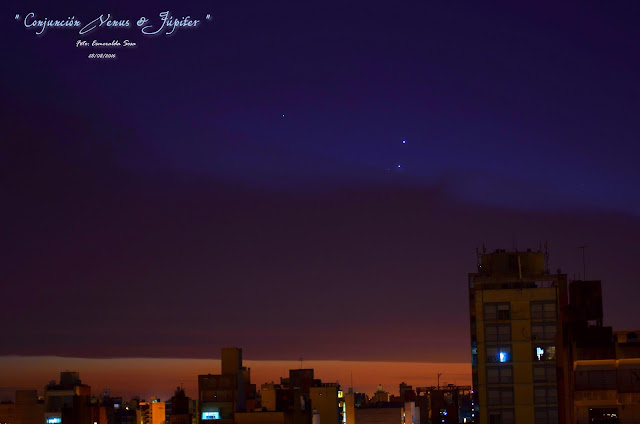En astronomía una conjunción se produce cuando dos cuerpos celestes llegan a tener la misma o casi la misma ascensión recta.
" Neptuno, Venus & Mercurio " - Foto: Esmeralda Sosa ( ROSARIO - ARGENTINA )
El 12 de abril del 2019 a las 6 hrs ( hora oficial de Argentina ), los planetas Neptuno,Venus y Mercurio se podían observar dentro de una circunferencia con un diámetro de 7° 09' 39".
Una extraordinaria conjunción se va a producir el 8 de septiembre del 2040.
Dentro de una circunferencia de 9° 42' de diámetro se van a encontrar los 5 planetas que se pueden visualizar a ojo desnudo, junto con una Luna con una edad de 2 días y un 5% de su cara iluminada.
A la derecha puede observarse la disposición de los cinco planetas dos días antes de que se produzca una agrupación más cerrada
A las 19 : 45 ( hora oficial de Argentina ), el planeta Júpiter ( el que se encontrará más bajo dentro del conjunto ), estará unos 7° por encima del horizonte, el Sol se ubicará unos 12° por debajo del horizonte oeste.
Posiciones aproximadas de los 5 planetas y la Luna
* Marte
* Venus
O Luna
* Saturno
* Mercurio
* Júpiter
Próximas Conjunciones Planetarias para el año 2019
( se consideran solo los planetas visibles a ojo desnudo ).
18 de Junio del 2019, Conjunción Mercurio - Marte
Hora ► 19 : 17 (hora oficial de Argentina)
Horizonte Oeste
Sol 15° debajo del horizonte
Mercurio 5° 23' sobre horizonte
Marte 5° 21' sobre horizonte
Separación Mercurio - Marte 14' 42"
Constelación Géminis
7 de Febrero del 2013, conjunción Mercurio - Marte en la constelación de Acuario, la separación entre ambos planetas era de 40' 37" a las 20:30 hora oficial de Argentina ( TU - 3 hrs ).
30 de Octubre del 2019, Conjunción Mercurio - Venus
Hora ► 20 :28 ( hora oficial de Argentina )
Horizonte oeste
Sol 12° 38' debajo del horizonte
Mercurio 7° 28' sobre horizonte
Venus 6° 41' sobre horizonte
Separación Mercurio - Venus 2° 33' 34"
Constelación Libra
5 de Febrero del 2016, conjunción Mercurio - Venus en la constelación de Sagitario, la separación entre ambos planetas era de 5° 5' 19" a las 5:30 hora oficial de Argentina ( TU - 3 hrs ).
24 de Noviembre del 2019, Conjunción Júpiter - Venus
Hora ► 20 : 52 ( hora oficial de Argentina )
Horizonte oeste
Sol 12° debajo del horizonte
Júpiter 10° 11' sobre horizonte
Venus 11° 17' sobre horizonte
Separación Júpiter - Venus 1° 29' 07"
Constelación Sagitario
30 de Junio del 2015, conjunción Júpiter - Venus en la constelación de Leo, la separación entre ambos planetas era de 21' 08" a las 19:30 hora oficial de Argentina ( TU - 3hrs ).
11 de Diciembre del 2019, Conjunción Saturno - Venus
Hora ► 21 : 08 ( hora oficial de Argentina )
Horizonte oeste
Sol 12° debajo del horizonte
Saturno 10°56' sobre horizonte
Venus 12° 35' sobre horizonte
Separación Saturno - Venus 1° 55' 15"
Constelación Sagitario
2 de Noviembre del 2016, conjunción Saturno - Venus en la constelación de Ofiuco, la separación entre ambos planetas era de 5° 22' 06" a las 20:30 hora oficial de Argentina ( TU - 3 hrs ).
Conjunciones Varias
( Fotos: Esmeralda Sosa /// ROSARIO - ARGENTINA )
Agradecimientos:
A Cachitus por TODO !
Licenciado en Física José Luis Lomáscolo
Esmeralda Sosa




















































